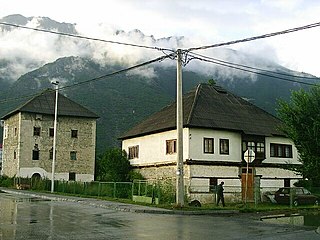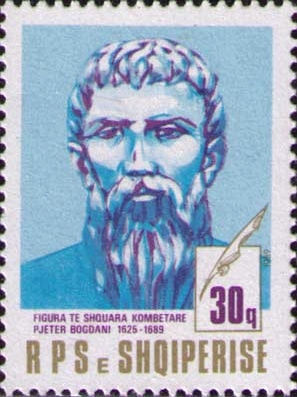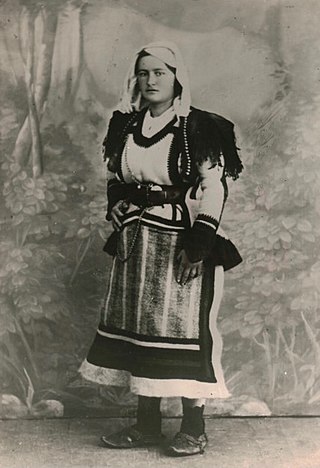
The League of Lezhë, also commonly referred to as the Albanian League, was a military and diplomatic alliance of the Albanian aristocracy, created in the city of Lezhë on 2 March 1444. The League of Lezhë is considered the first unified independent Albanian country in the Medieval age, with Skanderbeg as leader of the regional Albanian chieftains and nobles united against the Ottoman Empire. Skanderbeg was proclaimed "Chief of the League of the Albanian People," while Skanderbeg always signed himself as "DominusAlbaniae".

Gusinje is a small town in Montenegro in the northern region. According to the 2011 census, the town has a population of 1,673 and is the administrative center of Gusinje Municipality.

(Italian: Pietro Bogdano; 1627 – 6 December 1689) was the most original writer of Old Albanian literature. He was author of the Cuneus Prophetarum, 1685, the first prose work of substance written originally in (Gheg) Albanian. He organized a resistance against the Ottomans and a pro-Austrian movement in Kosovo in 1689 that included Muslim and Christian Albanians.
Albanians in Montenegro are an ethnic group in Montenegro of Albanian descent, which constitute 4.91% of Montenegro's total population. They are the largest non-Slavic ethnic group in Montenegro.

Kelmendi is a historical Albanian tribe (fis) and region in Malësia and eastern Montenegro. It is located in the upper valley of the Cem river and its tributaries in the Accursed Mountains range of the Dinaric Alps. The Vermosh river springs in the village of the same name, which is Albania's northernmost village. Vermosh pours into Lake Plav.

Kuči is a historical tribe (pleme) of Albanian origin and a region in central and eastern Montenegro, north-east of Podgorica, extending along the border with Albania. Processes of Slavicisation during the Ottoman era and onwards facilitated ethno-linguistic shifts within much of the community. As such, people from the Kuči today largely identify themselves as Montenegrins and Serbs, with a minority still identifying as Albanians. In other areas such as the Sandžak, many Muslim descendants of the Kuči today identify as Bosniaks.

Hoti is a historical Albanian tribe (fis) and sub-region of Malësia, a divided area located in northern Albania and southern Montenegro. Its geography is mostly mountainous, but some of its villages are on flat terrain near the banks of Lake of Shkodër.

Gruda is a Northern Albanian tribe and historical tribal region in southeastern Montenegro, just north of Lake Skadar, which includes the small town of Tuzi, in Podgorica. It is inhabited by a majority of ethnic Albanians.

Tringë Smajl Martini Ivezaj , known simply as Tringe Smajli, and as Yanitza outside Albania, was an Albanian guerrilla fighter who fought against the Ottoman Empire in the Malësia region. She was the daughter of Smajl Martini, a Catholic clan leader of the Grudë tribe of Malësia.
Francesco Antonio Santori was an Italian writer, poet and playwright of Arbëreshë descent. His play Emira is considered to be the first original Albanian drama ever written. The main character is a young and innocent girl who becomes a victim. Albanian literature of that time does not present many female characters like Ermira.

The Sanjak of Scutari or Sanjak of Shkodra was one of the sanjaks of the Ottoman Empire. It was established after the Ottoman Empire acquired Shkodra after the siege of Shkodra in 1478–9. It was part of the Eyalet of Rumelia until 1867, when it became a part, together with the Sanjak of Skopje, of the newly established Scutari Vilayet. In 1912 and the beginning of 1913 it was occupied by members of the Balkan League during the First Balkan War. In 1914 the territory of Sanjak of Scutari became a part of the Principality of Albania, established on the basis of the peace contract signed during the London Conference in 1913.
Luca Bogdano was an Ottoman poet of Albanian origin.
The literature of Kosovo is composed of literary texts written in Albanian, Serbian, Bosnian, and Turkish, specifically by authors of Kosovo. Kosovo produced several prominent writers in the Ottoman era. However, Ottoman authorities banned the written use of the Albanian language until 1912. This policy continued during Serb rule until the outbreak of World War II.

Kastrati is a historical Albanian tribe (fis) and region in northwestern Albania. It is part of the Malësia region. Administratively, the region is located in the Malësi e Madhe District, part of the Kastrati municipal unit. The centre of Kastrati is the village of Bajzë. The Kastrati tribe is known to follow the Kanuni i Malësisë së Madhë, a variant of the Kanun. They are proverbally known for their pride - Kastrati Krenar.
Matija Mazarek or Matija Masarek was an 18th-century Catholic priest. In the second half of the 18th century he was the archbishop of the Roman Catholic Diocese of Skopje. His reports to the Vatican are an important source for demography study of his diocese.

Trieshi is a historical Albanian tribe (fis) and region in Montenegro above the right bank of the Cem river near the Albanian border in Tuzi Municipality. It is part of the region of Malësia.

Albania has an embassy in Budapest and Hungary has an embassy and a consular office in Tirana. The history of diplomatic relations of Albania and Hungary dates back to 1912, when Albania declared its independence on November 28, 1912.

The Suma are a historical Albanian tribe (fis) and tribal region in Pult of north Albania. During the Ottoman period it formed a single bajrak.
The 1638 Ottoman expedition against Kelmendi was an Ottoman military campaign led by the Pasha of Bosnia in northern Albania against local tribes. The expedition was launched to punish the Kelmendi tribe and their associates for raids and brigandage, after a committee of merchants and representative of the local population went to Istanbul to petition Ottoman Sultan Murad IV to intervene.









